In the world of nutrition and culinary choices, the debate between canned and fresh foods often arises. One particular comparison that sparks discussion is the difference between canned spinach and its fresh counterpart. While both options offer nutritional benefits, taste, texture, and convenience play significant roles in determining which is better suited for various preferences and lifestyles. In this comprehensive exploration, we’ll delve into the pros and cons of both canned and fresh spinach to answer the question: Is canned spinach as good as fresh?
Understanding the Nutritional Profile

Canned Spinach
Canned spinach undergoes a preservation process that involves cooking the spinach before sealing it in cans. While this process helps retain some of its nutritional value, certain heat-sensitive nutrients may be lost in the process. Despite this, canned spinach still offers essential vitamins and minerals. It is a good source of fiber, which supports digestive health and promotes feelings of fullness. Additionally, canned spinach provides folate, a B-vitamin important for cell division and DNA synthesis. Iron is another key nutrient found in canned spinach, vital for oxygen transport in the blood and overall energy production.
However, it’s essential to be aware of the sodium content in canned spinach. To preserve the spinach, salt is often added during the canning process, resulting in higher sodium levels compared to fresh spinach. Excessive sodium intake can contribute to high blood pressure and other health issues, so individuals following a low-sodium diet should monitor their intake of canned spinach.
Fresh Spinach
Fresh spinach is celebrated for its abundance of nutrients and vibrant flavor profile. It is particularly notable for its high vitamin C content, providing nearly half of the recommended daily value in a 100-gram serving. Vitamin C is an antioxidant that supports immune function, collagen production, and iron absorption. Additionally, fresh spinach is rich in vitamin A, which is essential for vision health, immune function, and skin health. Vitamin K is another important nutrient found in fresh spinach, playing a crucial role in blood clotting and bone health.
One of the key benefits of fresh spinach is its versatility in culinary applications. Whether enjoyed raw in salads or cooked in various dishes, fresh spinach adds a nutritional boost and vibrant flavor to meals. However, it’s important to note that certain cooking methods, such as boiling, can lead to a significant loss of nutrients like vitamin C. To preserve the nutritional integrity of fresh spinach, cooking methods like steaming, stir-frying, or sautéing are recommended.
Evaluating Taste and Texture

Canned Spinach
Canned spinach undergoes a cooking and preservation process before being sealed in cans. As a result, its texture tends to be softer compared to fresh spinach. The prolonged cooking time can lead to a somewhat mushy consistency, which may not appeal to all palates. Additionally, canned spinach often has a slightly salty taste due to the salt used in the preservation process. While this saltiness can enhance certain dishes, it may overpower more delicate flavors or clash with specific culinary preferences.
Despite these drawbacks, canned spinach still retains some of its inherent spinach flavor. When incorporated into cooked dishes like casseroles or soups, canned spinach can contribute a savory depth and earthy undertones. However, its texture may not provide the same crispness and vibrancy as fresh spinach, which could impact the overall eating experience for some individuals.
Fresh Spinach
Fresh spinach is prized for its crisp texture and vibrant flavor profile. Whether enjoyed raw in salads or cooked in recipes, fresh spinach offers a satisfying crunch and robust taste that many find irresistible. Its leaves are tender yet resilient, providing a delightful contrast of textures in culinary creations.
In terms of taste, fresh spinach offers a delicate balance of sweetness and earthiness, with subtle hints of nuttiness. This nuanced flavor profile lends itself well to a wide range of dishes, from simple salads to complex entrees. Unlike canned spinach, fresh spinach typically lacks the salty undertones imparted by the preservation process, allowing its natural flavors to shine through.
However, it’s worth noting that the taste and texture of fresh spinach can vary depending on factors such as variety, freshness, and growing conditions. Younger spinach leaves tend to be milder and more tender, while mature leaves may have a slightly stronger flavor and tougher texture. Overall, the taste and texture of fresh spinach are highly prized by culinary enthusiasts for their versatility and culinary appeal.
Considering Convenience and Shelf Life

Canned Spinach
Canned spinach is renowned for its convenience and extended shelf life. Once sealed in cans, spinach can last for several years without refrigeration, making it an ideal pantry staple for those seeking long-term storage options. This longevity ensures that canned spinach is readily available whenever needed, providing a convenient solution for quick and easy meal preparation.
Moreover, the canned format eliminates the need for time-consuming preparation steps typically associated with fresh produce. With canned spinach, there’s no washing, chopping, or trimming required—simply open the can and add the spinach directly to your dish. This time-saving convenience is especially beneficial for busy individuals or those with hectic schedules.
However, it’s essential to consider the limitations of canned spinach regarding its shelf life once opened. While unopened cans can be stored for an extended period, opened cans of spinach should be refrigerated and consumed within 3 to 4 days to maintain freshness and prevent spoilage. Additionally, the salt used in the preservation process may contribute to a higher sodium content in canned spinach, which could be a consideration for individuals monitoring their sodium intake.
Fresh Spinach
Fresh spinach, while celebrated for its superior taste and nutritional content, has a relatively short shelf life compared to its canned counterpart. Fresh spinach typically needs to be consumed within about a week and a half of purchase to ensure optimal freshness and flavor. Proper storage is crucial to prevent wilting and spoilage, with refrigeration recommended to maintain quality.
Despite its perishable nature, fresh spinach offers versatility in culinary applications. Whether used raw in salads or cooked in various dishes, fresh spinach adds a nutritional boost and vibrant flavor to meals. However, it’s essential to note that the preparation of fresh spinach may require washing, trimming, and chopping, which can add time and effort to meal preparation.
For those seeking to extend the shelf life of fresh spinach, freezing can be a viable option. By blanching and freezing fresh spinach leaves, individuals can preserve their quality and nutritional value for an extended period, allowing for future use in recipes.
Cost Considerations

Canned Spinach
Canned spinach is often praised for its affordability and cost-effectiveness compared to fresh spinach. The average price per pound of canned spinach is notably lower than that of fresh spinach, making it an attractive option for budget-conscious consumers. This lower price point allows individuals to enjoy the nutritional benefits of spinach without breaking the bank, making it accessible to a wider range of households.
Moreover, the economical nature of canned spinach extends beyond its upfront cost. Since canned spinach has a longer shelf life and can be stored without refrigeration, there is less risk of spoilage and waste. This can translate to additional savings over time, as individuals can purchase canned spinach in bulk or take advantage of sales without worrying about immediate consumption.
Another cost-saving aspect of canned spinach is its water content. Spinach is over 90% water, and during the canning process, this water is retained, resulting in a higher yield of spinach per unit weight compared to fresh spinach. As a result, consumers get more spinach for their money when purchasing canned varieties, further enhancing its cost-effectiveness.
Fresh Spinach
While fresh spinach offers superior taste and nutritional quality, it is typically priced higher than canned spinach on a per-pound basis. This higher cost reflects factors such as seasonal availability, perishability, and transportation expenses associated with fresh produce. As a result, fresh spinach may be perceived as a premium option for those willing to invest in quality and flavor.
Despite its higher price point, fresh spinach still holds value for individuals seeking the freshest ingredients and optimal taste in their culinary creations. The vibrant color, crisp texture, and delicate flavor of fresh spinach can elevate dishes to gourmet levels, making it a worthwhile investment for discerning palates.
However, it’s important to consider the potential for waste when purchasing fresh spinach. Due to its shorter shelf life and perishable nature, there is a risk of spoilage if not consumed promptly. This can result in financial losses if unused portions of fresh spinach are discarded, especially if purchased in large quantities.
Exploring Culinary Versatility

Canned Spinach
While canned spinach may have limitations in terms of taste and texture, it remains a versatile ingredient in many recipes. Its pre-cooked state eliminates the need for extensive preparation, making it convenient for quick and easy meal solutions. Canned spinach pairs well with savory flavors and can be incorporated into various dishes such as casseroles, soups, and dips.
Fresh Spinach
Fresh spinach shines in its culinary versatility, offering endless possibilities for both raw and cooked applications. From vibrant salads to hearty soups and savory entrées, fresh spinach adds a nutritional boost and vibrant flavor to any dish. Its crisp texture and delicate taste make it a favorite among chefs and home cooks alike.
Conclusion
In the debate between canned spinach and fresh spinach, both options have their merits and drawbacks. While canned spinach offers convenience and extended shelf life, fresh spinach boasts superior taste, texture, and nutritional content. Ultimately, the choice between canned and fresh spinach depends on individual preferences, dietary considerations, and culinary needs. Whether enjoying the convenience of canned spinach or savoring the freshness of its counterpart, incorporating spinach into your diet is a delicious and nutritious choice.





